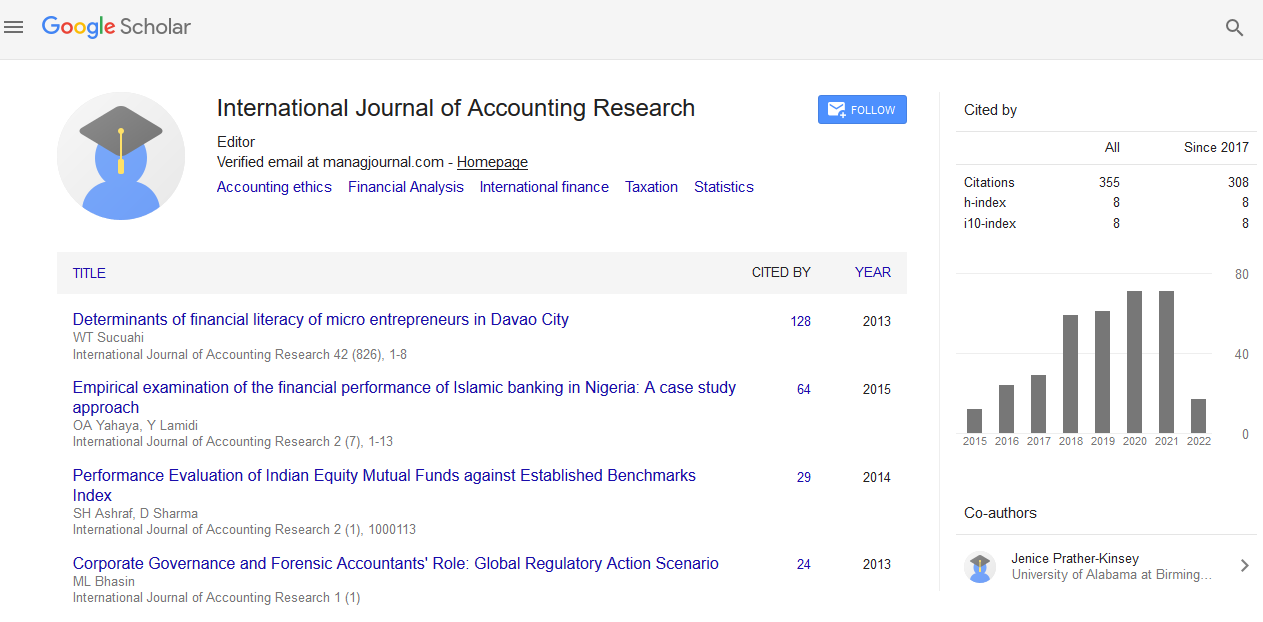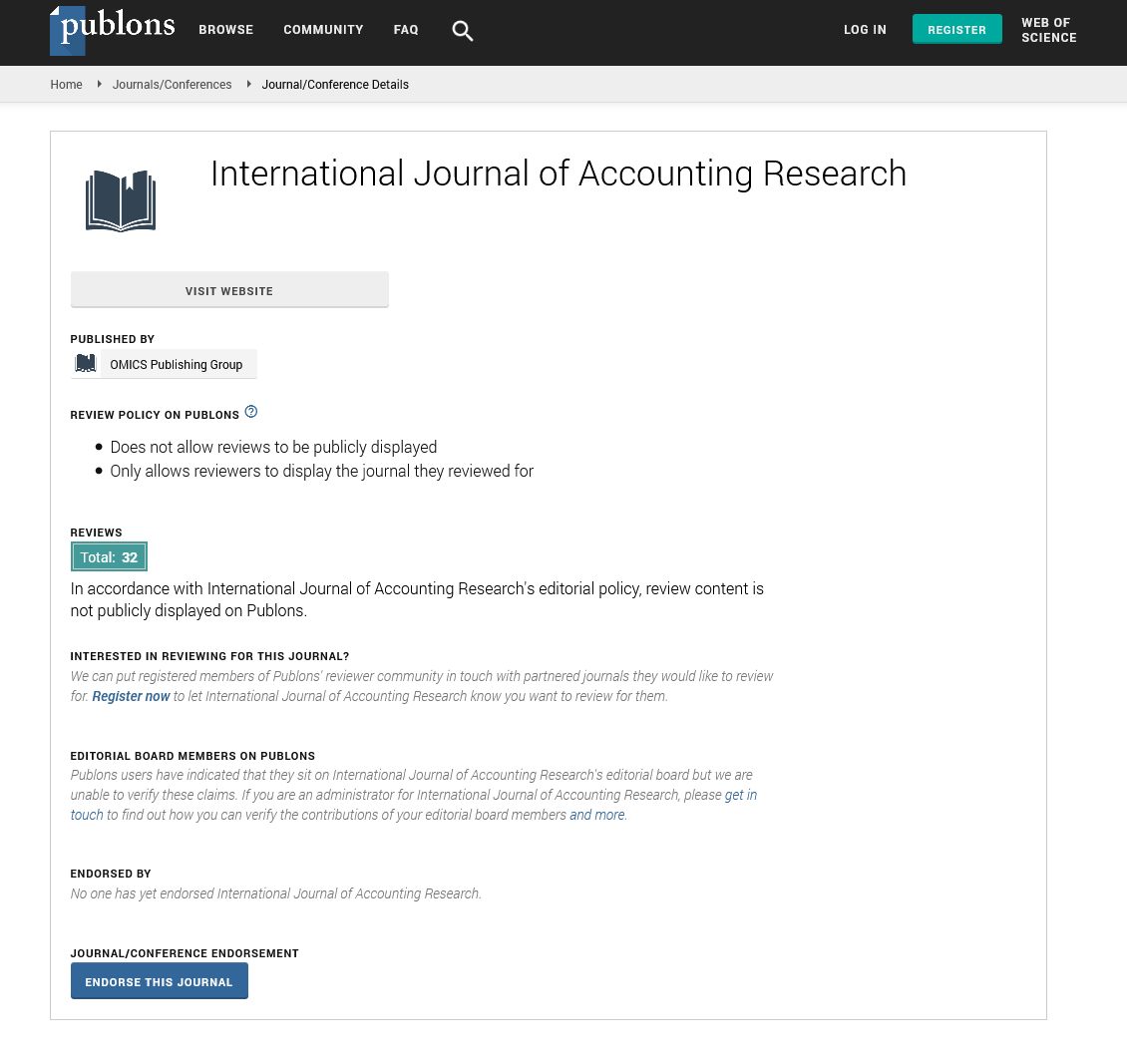Indexed In
- Open J Gate
- RefSeek
- Hamdard University
- EBSCO A-Z
- Scholarsteer
- Publons
- Euro Pub
- Google Scholar
Useful Links
Share This Page
Journal Flyer

Open Access Journals
- Agri and Aquaculture
- Biochemistry
- Bioinformatics & Systems Biology
- Business & Management
- Chemistry
- Clinical Sciences
- Engineering
- Food & Nutrition
- General Science
- Genetics & Molecular Biology
- Immunology & Microbiology
- Medical Sciences
- Neuroscience & Psychology
- Nursing & Health Care
- Pharmaceutical Sciences
Commentary - (2023) Volume 11, Issue 3
Time Series Analysis and Deep Learning in Stock Market Prediction
Kong Soon*Received: 02-Jun-2023, Manuscript No. IJAR-23-22165; Editor assigned: 06-Jun-2023, Pre QC No. IJAR-23-22165 (PQ); Reviewed: 20-Jun-2023, QC No. IJAR-23-22165; Revised: 27-Jun-2023, Manuscript No. IJAR-23-22165 (R); Published: 05-Jul-2023, DOI: 10.35248/2472-114X.23.11.335
Description
The stock market is a highly dynamic and complex system influenced by numerous factors, including economic indicators, company performance, market sentiment, and geopolitical events. Accurately predicting stock market movements is a challenging task, but advancements in Machine Learning (ML) techniques have shown potential results. In this study, they will explore the applications of machine learning in stock market prediction, discuss recent advancements, and highlight the challenges faced in this domain.
Advancements in machine learning for stock market prediction
Feature engineering: Feature engineering involves selecting and creating relevant input variables for ML models. Traditional financial metrics such as price, volume, and volatility are commonly used. However, advancements in feature engineering have introduced new variables, including sentiment analysis of news and social media, economic indicators, and alternative data sources such as satellite imagery and web scraping. These additional features provide richer information for ML models to learn from and potentially improve prediction accuracy.
Time series analysis: Stock market data is inherently sequential in nature, with historical prices and volumes forming a time series. ML algorithms specifically designed for time series analysis, such as Recurrent Neural Networks (RNNs) and Long Short-Term Memory (LSTM) networks, have gained popularity. These models can capture temporal dependencies and patterns, making them suitable for predicting future stock prices based on historical data.
Deep learning: Deep learning, a subset of ML, has demonstrated remarkable capabilities in analyzing complex data and extracting meaningful patterns. Convolutional Neural Networks (CNNs), originally developed for image processing, have been adapted for analyzing stock market data, particularly for pattern recognition in technical indicators. Deep learning models can automatically learn and extract intricate relationships, allowing for more accurate predictions.
Ensemble methods: Ensemble methods combine predictions from multiple ML models to improve overall accuracy and stability. Techniques such as bagging, boosting, and stacking have been applied to stock market prediction. Ensemble models leverage the strengths of different algorithms, reduce biases, and enhance robustness, thereby providing more reliable forecasts.
Challenges in machine learning for stock market prediction
Limited data and noisy signals: Stock market data is limited by its historical nature, with typically less data available for training ML models. Moreover, financial data is often noisy, containing inconsistencies, outliers, and conflicting signals. This makes it challenging to discern genuine patterns from random fluctuations, potentially leading to overfitting and unreliable predictions.
Non-Stationarity and market regime shifts: Stock market dynamics can change over time due to various factors such as economic cycles, policy changes, or unexpected events. Adapting ML models to account for non-stationarity and regime shifts is an ongoing challenge.
Market efficiency and randomness: The stock market is generally considered to be efficient, meaning that prices reflect all available information. Predictive models based solely on historical data may not consistently outperform the market. Randomness and unpredictable events can significantly impact stock prices, making accurate predictions difficult.
Interpretability and explainability: ML models, especially deep learning models, are often referred to as black boxes due to their complex architectures and decision-making processes. This lack of interpretability can be a challenge, as stakeholders may require transparency in understanding how predictions are made, especially in highly regulated industries.
Conclusion
Machine learning techniques have brought significant advancements to stock market prediction, offering new insights and improved accuracy compared to traditional approaches. The ability to analyze vast amounts of data, incorporate alternative data sources, and leverage sophisticated algorithms has provided valuable tools for investors and traders.
However, challenges remain in effectively applying machine learning to stock market prediction. Dealing with limited and noisy data, adapting to non-stationarity, accounting for market efficiency, and ensuring interpretability are ongoing areas of research. Additionally, the limitations of historical data and the unpredictable nature of financial markets remind us that ML models should be used as decision-support tools rather than as standalone predictors.
Despite the challenges, machine learning continues to evolve and contribute to advancements in stock market prediction. As technology progresses and data availability improves, they can expect further developments in ML models, helping investors navigate the complexities of the stock market and make more informed decisions.
Citation: Soon K (2023) Time Series Analysis and Deep Learning in Stock Market Prediction. Int J Account Res. 11:335.
Copyright: © 2023 Soon K. This is an open-access article distributed under the terms of the Creative Commons Attribution License, which permits unrestricted use, distribution, and reproduction in any medium, provided the original author and source are credited.


